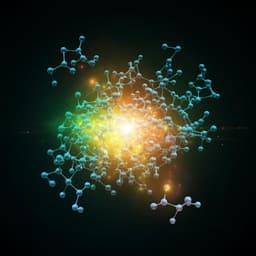
Chemistry
Asymmetric electron acceptor enables highly luminescent organic solar cells with certified efficiency over 18%
C. He, Z. Chen, et al.
Discover how the innovative design of an asymmetric non-fullerene acceptor, BO-5CI, is revolutionizing organic solar cells (OSCs) by enhancing luminescence while maintaining charge collection efficiency. This groundbreaking research by Chengliang He, Zeng Chen, Tonghui Wang, and colleagues showcases a record-high electroluminescence efficiency and impressive power conversion rates, pointing towards a brighter future in renewable energy.
~3 min • Beginner • English
Introduction
Organic photovoltaics offer advantages such as flexibility and low cost, but lag inorganic counterparts due to larger open-circuit voltage (VOC) losses. Recent non-fullerene acceptors (NFAs) reduce VOC loss by bringing charge-transfer (CT) state energies closer to local-exciton (LE) energies and by reducing non-radiative decay. Y6-type NFAs with reduced molecular symmetry (banana-shaped, chiral packing) have delivered >18% PCE. The next logical step is fully asymmetric acceptors, which can carry larger dipole moments and stronger intermolecular interactions, potentially altering packing, energetics, and optoelectronic properties. The research question is whether an asymmetric acceptor can concurrently enhance luminescence (reducing non-radiative losses) and maintain efficient charge generation/collection. The study designs asymmetric acceptors (notably BO-5Cl) and interrogates how asymmetry-induced diverse donor–acceptor (D:A) interfacial conformations tune LE–CT energetics, charge dynamics, and ultimately device performance in binary and ternary blends.
Literature Review
The paper situates the work within advances in NFA-based OSCs: first-generation IT-4F derivatives achieved >15% PCE, while Y6 derivatives exceed 18%. Molecular symmetry has evolved from symmetric fullerenes to less symmetric Y6, prompting interest in asymmetric acceptors. Reported asymmetric Y-series NFAs are categorized as: (i) asymmetric backbones; (ii) asymmetric side chains; (iii) asymmetric terminals. Asymmetry is proposed to increase dipole moments and intermolecular interactions, improving packing and potentially reducing VOC losses. However, a detailed understanding of how asymmetry affects interfacial molecular conformations, energetics (LE–CT offsets), and optoelectronics is lacking; this study addresses these gaps.
Methodology
- Molecular design and synthesis: Four Y-series NFAs were synthesized: symmetric BO-4F (IC-2F terminals) and BO-4Cl (IC-2Cl terminals), and asymmetric BO-6Cl (IO-4Cl + IO-4Cl asymmetry previously reported) and BO-5Cl (IO-4Cl on one end and T-Cl on the other). Syntheses used Knoevenagel condensation to couple end-groups to the fused BTP core. Structures were verified (Supplementary Figs. 3–7); solubility confirmed in common solvents.
- Electronic structure and spectroscopy: UV–vis absorption and PL in solution and thin films; TD-DFT/TD-DFT NTO analyses for S1 character and state dipole moments; cyclic voltammetry and UPS for ionization potentials/electron affinities and donor–acceptor offsets; temperature-dependent electroluminescence (EL) to resolve LE/CT vibrational structure and infer ΔE_LE-CT.
- Structural characterization: Single-crystal X-ray diffraction for BO-4F, BO-4Cl, BO-5Cl to determine packing motifs, noncovalent O···S interactions, and π–π stacking distances; transfer integral calculations to assess electron-transport networks.
- Thin-film morphology: GIWAXS to assess crystallinity, orientation (face-on), π–π and lamellar spacings; GISAXS with Debye–Anderson–Brumberger model to extract acceptor domain sizes and intermixing correlation lengths in pristine and blend films.
- Excited-state dynamics: Femtosecond transient absorption (TA) with 800 nm excitation (acceptor-selective) to track GSB/SE and donor GSB rise; biexponential kinetic fits for interfacial hole transfer (τ1) and diffusion-limited dissociation (τ2). Time-resolved PL (TRPL) in solution, PS matrix, and blends to extract exciton lifetimes, exciton dissociation rates/efficiencies. Marcus theory modeling of hole transfer rates versus ionization potential (HOMO) offsets and reorganization energies computed by DFT.
- D–A complex modeling: TD-DFT on PM6:acceptor interfacial complexes to calculate LE and CT energies and ΔE_LE-CT for distinct interfacial conformations (end-group specific contacts), revealing dual interfacial manifolds in BO-5Cl.
- Device fabrication and testing: Conventional architecture ITO/PEDOT:PSS/active layer/PFN-Br/Ag; active layers spin-coated from chloroform (PM6:acceptor 1:1.2, 17.6 mg/mL) with additives; PFN-Br interlayer by spin coating; Ag evaporation. Active area 0.0925 cm²; J–V under AM 1.5G calibrated simulator; EQE measured; EL and EQE_EL characterized; certified measurements via shadow mask (0.05979 cm²) and NIM, China.
Key Findings
- Asymmetric BO-5Cl exhibits a high S1 state dipole (~15 D) versus BO-4Cl (~4 D) and a modest blue shift in absorption relative to BO-4Cl (~80 meV by TD-DFT). Films show strong aggregation-induced red shifts and face-on orientation; π–π distances ~3.5 Å and lamellar ~16 Å consistent with single crystals.
- Single-crystal packing of BO-4Cl and BO-5Cl supports 3D electron-transport networks; transfer integrals >50 meV in key directions; BO-5Cl shows dense stacking and alternating hopping channels (e.g., 44.6/37.7 meV in-plane; ~59.6/11.4 meV along stacks).
- GISAXS indicates similar acceptor domain sizes across blends (2Rg ~9–12 nm), with PM6:BO-5Cl having the smallest intermixing domain size ξ, favorable for exciton dissociation.
- TA kinetics (800 nm excitation) show donor GSB rise via hole transfer with biexponential components: PM6:BO-4Cl τ1=0.236–0.265±0.027 ps; τ2~6.56±0.66 ps; PM6:BO-5Cl τ1=0.315±0.035 ps; τ2=23.19±2.32 ps; ternary PM6:BO-4Cl:BO-5Cl τ1≈0.265±0.027 ps; τ2≈10.43±1.04 ps. Estimated exciton dissociation efficiencies: PM6:BO-4Cl 95.8%, PM6:BO-5Cl 89.4%, ternary 93.1%.
- TRPL-derived exciton lifetimes in PS matrix: BO-4Cl 1.49 ns; BO-5Cl 2.14 ns (comparable to Y6 ~1.6 ns). From TRPL, exciton dissociation rates/efficiencies: PM6:BO-4Cl 19.3 ns⁻¹ and 97%; PM6:BO-5Cl 7.9 ns⁻¹ and 94%, aligning with TA trends.
- Marcus analysis: With small reorganization energies (λ≈0.09–0.10 eV), efficient hole transfer persists even at very small donor–acceptor ΔIP offsets (~0.02 eV), far below the ~0.3 eV often cited.
- TD-DFT on interfacial complexes: PM6:BO-4Cl complexes show ΔE_LE-CT ~0.22–0.23 eV. PM6:BO-5Cl has two manifolds: T-Cl–bound complexes with ΔE_LE-CT ~0.21–0.24 eV (driving dissociation) and IO-4Cl–bound complexes with much smaller ΔE_LE-CT ~0.07–0.08 eV (stronger LE–CT hybridization), underpinning reduced non-radiative losses.
- Temperature-dependent EL: Vibrational satellites at 80 K (BO-4Cl ~130 meV; BO-5Cl ~170 meV). In blends, second EL peak has strong CT contribution; inferred ΔE_LE-CT ≤160 meV in PM6:BO-5Cl and >170 meV in PM6:BO-4Cl.
- Device performance (ITO/PEDOT:PSS/active/PFN-Br/Ag):
• PM6:BO-4F: VOC 0.833 V, FF 0.772, PCE 16.73%.
• PM6:BO-4Cl: VOC 0.841 V, FF 0.794, best PCE 17.43%.
• PM6:BO-5Cl: VOC 0.958 V, PCE 15–16%; EQE_EL = 0.1% (10.2×10⁻⁴); non-radiative loss ΔE3=0.184 eV; total VOC loss 0.522 eV (among the lowest reported for high-performance OSCs); EQE_PY ≈80%.
• PM6:BO-6Cl: VOC 0.944 V; total VOC loss 0.536 eV; EQE_EL 7.2×10⁻⁴.
• Ternary PM6:BO-4Cl:BO-5Cl (20 wt% BO-5Cl): EQE_EL tripled vs PM6:BO-4Cl; ΔE3 reduced from 0.229 to 0.198 eV; ΔE2 reduced to 0.028 eV; total loss reduced from 0.539 to 0.496 eV; VOC increased by 33 mV; enhanced EQE(600–850 nm); best PCE 18.56% (certified 18.2%).
- Energy-loss analysis (selected from Table 2):
• PM6:BO-5Cl: EPV=1.48 eV; qVOC=0.958 eV; Eloss=0.522 eV; qVSQ=1.194 eV; qVrad=1.142 eV; ΔE1=0.286 eV; ΔE2=0.052 eV; ΔE3=0.184 eV; EQE_EL=10.2×10⁻⁴; experimental qV_non-rad=0.178 eV.
• PM6:BO-4Cl: EPV=1.38 eV; qVOC=0.841 eV; Eloss=0.539 eV; ΔE3=0.221 eV; EQE_EL=1.4×10⁻⁴.
• Ternary PM6:BO-4Cl:BO-5Cl: EPV=1.37 eV; qVOC=0.874 eV; Eloss=0.496 eV; ΔE2=0.028 eV; ΔE3=0.192 eV; EQE_EL=4.6×10⁻⁴; experimental qV_non-rad=0.198 eV.
Discussion
Asymmetry in BO-5Cl creates diverse D:A interfacial conformations that generate a dual electronic manifold: one set of complexes (T-Cl bound) with moderate ΔE_LE-CT providing sufficient driving force for fast exciton dissociation, and another set (IO-4Cl bound) with very small ΔE_LE-CT enabling strong LE–CT hybridization and suppressed non-radiative recombination. This duality balances charge generation and recombination, yielding simultaneously high EQE_PY and high electroluminescence (EQE_EL), which translates into low non-radiative voltage losses and elevated VOC. Structural analyses show that BO-5Cl retains efficient 3D electron-transport networks and face-on orientation in blends, while GISAXS-derived domain sizes stay within the optimal 9–12 nm range for exciton harvesting.
Kinetic measurements corroborate the mechanism: ultrafast interfacial dissociation (hundreds of fs) with biexponential kinetics reflecting interfacial and diffusion-mediated processes. Marcus analysis shows that, with small reorganization energies, efficient hole transfer persists at very small energy offsets, explaining the success of near-zero-offset systems. Temperature-dependent EL and TD-DFT validate reduced ΔE_LE-CT and stronger LE–CT mixing in BO-5Cl-based interfaces, rationalizing the record-low non-radiative losses.
Incorporating BO-5Cl as a third component in PM6:BO-4Cl preserves the main recombination centers while significantly increasing EQE_EL and reducing both non-ideal radiative and non-radiative losses, boosting VOC and JSC to deliver a certified 18.2% PCE. The ternary approach leverages the asymmetric acceptor to induce a broader spectrum of interfacial conformations, extending the benefits of asymmetry beyond binary blends.
Conclusion
The study introduces an asymmetric non-fullerene acceptor, BO-5Cl, that achieves a favorable balance between charge generation and recombination in PM6-based organic solar cells. BO-5Cl enables highly luminescent devices with EQE_EL ≈0.1%, exceptionally low non-radiative voltage loss (≈0.178 eV), and PCE >15% in binary blends. When used as a third component with PM6:BO-4Cl, it delivers a best PCE of 18.56%, with a certified 18.2%, among the highest for OSCs, primarily by reducing total voltage losses. Comprehensive experimental (spectroscopy, morphology, device) and theoretical (TD-DFT, Marcus analysis) evidence links performance gains to asymmetric-induced dual interfacial electronic states with small ΔE_LE-CT, enhancing LE–CT hybridization and maintaining adequate driving force for exciton dissociation.
Future research directions include quantitatively assessing static/dynamic energetic disorder at interfaces and in transport states, optimizing spectral coverage and morphology for higher JSC in asymmetric acceptor systems, and generalizing the asymmetric design strategy to other donor matrices and multicomponent blends.
Limitations
- While BO-5Cl reduces voltage losses and increases VOC, its blue-shifted absorption relative to symmetric analogs limits spectral coverage, contributing to lower JSC and PCE in binary devices compared to BO-4F/BO-4Cl.
- Electron mobility in PM6:BO-5Cl is reported as about half that in PM6:BO-4Cl (SCLC), suggesting potential increased static disorder; however, mobility partially recovers in ternary blends, indicating complex morphology–transport relationships.
- The precise roles of static/dynamic energetic disorder, possible back transfer, excimer formation, and triplet pathways require further investigation; the authors note ongoing simulations and excited-state calculations to quantify these effects.
Related Publications
Explore these studies to deepen your understanding of the subject.







